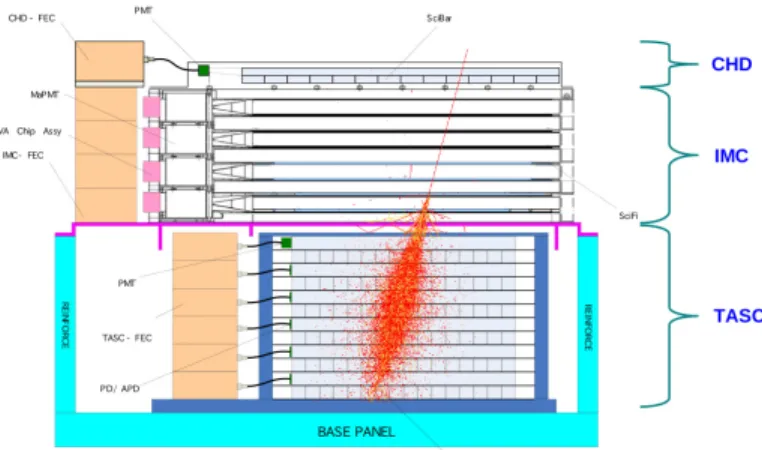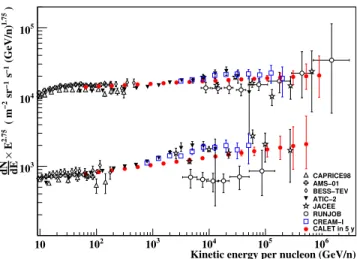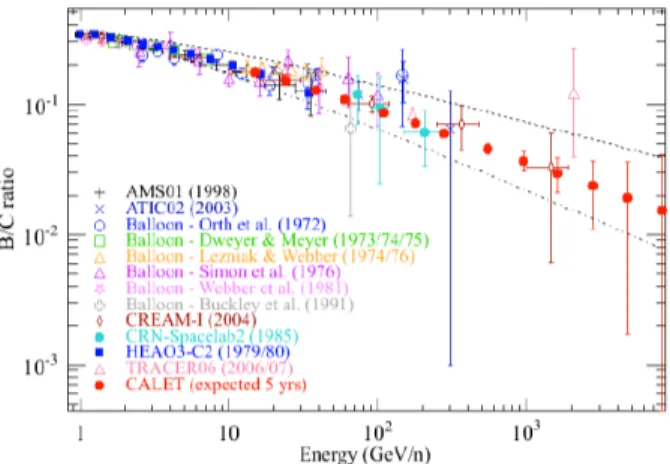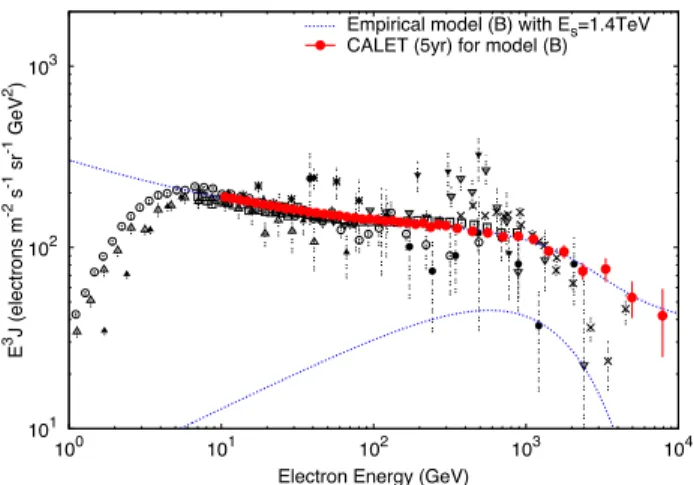Frascati Physics Series Vol. 58 (2014)
Frontier Objects in Astrophysics and Particle Physics May 18-24, 2014
The CALET mission on the International Space Station Paolo Maestro
Department of Physical Sciences, Earth and Environment University of Siena, via Roma 56, 53100 Siena (Italy)
for the CALET collaboration
Abstract
The CALorimetric Electron Telescope (CALET) is an astroparticle physics experiment currently under preparation to be installed on the International Space Station. Its main scientific goal is to search for possible clues of the presence of astrophysical sources of high-energy electrons nearby the Earth or signatures of dark matter, by measuring accurately the electron spectrum up to several TeV. CALET will also investigate the mechanism of cosmic-ray (CR) acceleration and propagation in the Galaxy, by performing direct measurements of the energy spectra and elemental composition of CR nuclei from H to Fe up to several hundreds of TeV, and the abundance of trans-iron elements at few GeV/amu up to about Z=40. The instrument consists of two layers of segmented plastic scintillators to identify the particle charge, a thin tungsten-scintillating fiber calorimeter providing accurate particle tracking, and a thick crystal calorimeter to measure the energy of CRs with excellent resolution and electron/hadron separation up to the multi-TeV scale. In this paper, we will review the status of the CALET mission, the instrument configuration and its performance, and the expected measurements of the different components of the cosmic radiation in 5 years of observations.
1 Introduction
CALET (CALorimetric Electron Telescope) is a space-based detector devel-oped by a Japanese led international collaboration to directly measure the high-energy cosmic radiation on the International Space Station (ISS). CALET is scheduled to be launched in JFY12014 by the Japanese rocket HTV (H-IIA Transfer Vehicle) and robotically installed on the Japanese Experiment Module Exposure Facility (JEM-EF) on ISS. The CALET mission will address many of the outstanding questions of High-Energy Astrophysics, such as the origin of cosmic rays (CR), the mechanism of CR acceleration and galactic propagation, and the existence of dark matter and nearby CR sources, by measuring accu-rately the fluxes of CR electrons, γ rays and nuclei in a wide energy window from few GeV up to the TeV region 1).
2 The CALET instrument and its performance
The CALET instrument consists of a Total AbSorption Calorimeter (TASC), a finely segmented pre-shower IMaging Calorimeter (IMC), and a CHarge De-tector (CHD) (Fig. 1). The TASC is a homogeneus calorimeter made of 192 Lead Tungstate (PWO) “logs” (20×19×320 mm3) arranged in 12 layers. The
logs in the top layer are readout by photomultiplier tubes (PMTs), while a dual photodiode/avalanche-photodiode system is used for the readout of the remaining layers. The TASC is specifically designed to measure the energy of the incident particle with excellent energy resolution: ∼2% for e± and γ rays above 100 GeV, ∼40% for 1 TeV protons and ∼30% for nuclei above few hundreds of GeV/amu. Moreover, exploting its shower imaging capabilities, a proton rejection >105 can be achieved, sufficient to keep the proton con-tamination below a few percent in the observation of CR electrons in the TeV region 2).
The IMC consists of 7 tungsten plates interleaved with double layers of 1 mm2
cross-section scintillating fibers (SciFi), arranged in belts along orthogonal di-rections and readout by multianode PMTs, and is capped by an additional
Figure 1: Schematic view of CALET. The picture of a simulated shower is superimposed.
SciFi layer pair. Its surface area is 45×45 cm2and its total thickness ∼3
radi-ation lengths (X0). The IMC fine granularity allows to measure precisely the
incident particle trajectory (with angular resolution better than 1◦), identify the starting point of the shower and separate the incident from backscattered particles.
The charge of the CR nuclei is measured via the Z2dependence of the specific ionization loss in a double layered, segmented, plastic scintillator array (CHD) positioned above the IMC. Each layer is composed of 14 scintillator paddles (3.2×1.0×44.8 cm3) each readout by a PMT. Taking advantage of its excellent charge resolution (∼0.1 electron charge units (e) for B, ∼0.2e for Fe) 3, 4), CHD can resolve individual chemical elements from Z=1 to Z=40.
The total thickness of the instrument is equivalent to 30 X0 and 1.3 proton
interaction length, the total weight is 650 kg. The effective geometrical factor of CALET for high-energy electrons and nuclei is ∼1200 cm2sr.
Prototypes of the CHD, IMC and TASC detectors were extensively tested at CERN in 2012 with beams of accelerated muons, electrons from 10 to 290 GeV, and protons from 30 to 400 GeV, and in 2013 with beams of ion fragments at 13 and 30 GeV/amu respectively, produced by the spallation of a primary Pb beam at onto a Be target. Results of the data analysis clearly demonstrate that the measured detector perfomance meets the design specifications 5).
3 CALET science goals
3.1 Acceleration and propagation of CR nuclei
It is nowadays generally accepted that CRs are accelerated in blast waves of su-pernova remnants (SNRs), which are the only galactic candidates known with sufficient energy output to sustain the CR flux. Recent measurements of γ-ray emission from several SNRs 6, 7, 8) provided evidence for hadronic CR ac-celeration in SNR shocks. However several questions remain unanswered. For instance, it is not clear if diffusive shock acceleration occurs in isolated SNR or in multiple remnants embedded in a turbulent stellar association; if there are different astrophysical sites associated with different energy or element regimes; if the knee in the all CR-particle spectrum is due to a rigidity-dependent limit, above which the diffusive shock acceleration becomes inefficient; how the shock is modified by the dynamical interaction with the accelerated particles 9). In order to enhance our knowledge of these physical processes, direct measure-ments of the CR chemical composition and individual energy spectra of CR nuclei, more accurate than the currently available ones and approaching the PeV energy region, are needed. CALET will be able to identify CR nuclei with individual element resolution and measure their energies in the range from a few tens of GeV to several hundreds of TeV. In 5 years of data taking on the ISS, it is expected to extend the proton energy spectrum up to ∼900 TeV, the He spectrum up to 400 TeV/amu (Fig. 2) and measure the energy spectra of the more abundant heavy nuclei with sufficient statistical precision up to ∼20 TeV/amu for C and O and 9-10 TeV/amu for Ne, Mg, Si and Fe. These data would allow to measure accurately the spectral shape of the most abundant CR elements and investigate the presence of possible spectral break in the flux of nuclei as the one recently reported by CREAM 10) and PAMELA 11), but not confirmed by AMS-02 12).
Information on the CR propagation in the galaxy may be obtained by measur-ing the ratio of abundances of CR secondary-to-primary elements (like B/C or sub-Fe/Fe), which is known to decrease, following a power-law in energy E−δ, where δ is the propagation index. This is a key parameter and its accurate measurement is crucial to derive the spectrum at the source by correcting the observed spectral shape for the energy dependence of the propagation term. The B/C data at low energies (<100 GeV/amu) favor δ ≈ 0.6 which is
some-Kinetic energy per nucleon (GeV/n) 10 102 103 104 105 106 ) 1.75 (GeV/n) −1 s −1 sr −2 ( m 2.75 E × dE dN 103 4 10 5 10 CAPRICE98 AMS−01 BESS−TEV ATIC−2 JACEE RUNJOB CREAM−I CALET in 5 y
Figure 2: Expected CALET measurement (red dots) of the energy spectra of proton and He after 5 years of observation on the ISS, compared with a com-pilation of direct measurements.
what steeper than the trend observed in high energy (100-1000 GeV/amu) data which seem to flatten to δ ≈ 0.4. However the high-energy measurements pro-vided by balloon experiments 13, 14) suffer from statistical limitations and large systematic errors, stemming from the corrections for the nuclei produced by CR interaction with the residual atmospheric overburden at flight altitude and do not allow to constraint tightly the value of δ and discriminate among different propagation models. Taking advantage of its long exposure in space and the absence of atmosphere, CALET will provide new data to improve the accuracy of the present measurements above 100 GeV/amu and extend them above 1 TeV/amu (Fig. 3).
Moreover, exploiting the CHD particle identification capability, CALET will measure the abundances of ultra-heavy CRs at few GeV/amu in the 26<Z≤40 charge range with an expected statistics ∼2-4 times larger than TIGER 15). 3.2 CR electrons: astrophysical sources and dark matter
Unlike the hadronic component of CRs, electrons, during their diffusion in the Galaxy, suffer radiative energy losses proportional to their squared energy.
Figure 3: A compilation of the B/C ratio as a function of energy per nucleon and the expectation for CALET after 5 years of observations (red dots).
Thus TeV electrons observed at Earth likely originated in sources younger than 105 years and <1 kpc far from the Solar System. Since the number of such nearby SNRs is limited (e.g.: Vela, Monogem, Cygnus Loop remnants, and few others), the electron energy spectrum around 1 TeV could exhibit spectral fea-tures and, at very high energies, a measurable anisotropy in the electron arrival directions would be expected, due to the locality of the possible sources. An al-ternative explation for the features recently observed in the electron spectrum by the balloon-borne experiment ATIC 16) and the increase in the positron fraction measured by the space-based detectors PAMELA 17), Fermi 18) and AMS-02 19) is that they could be signatures of decay or annihilation of dark matter particles. Thanks to its excellent energy resolution, electron/hadron discrimination power, and long exposure in space, CALET will be able to per-form a precision measurement of the electron spectral shape from few GeV up to 10 TeV, as shown in Fig. 4, where the expected statistics of CALET after 5 years of observation is estimated according to an empirical model of the eletron+positron flux, including a source contribution from dark matter or a nearby pulsar, and fitting simultaneously the observed positron and electron data 20).
101 102 103 100 101 102 103 104 E 3J (electrons m -2 s -1 sr -1 GeV 2)
Electron Energy (GeV)
Empirical model (B) with Es=1.4TeV CALET (5yr) for model (B)
Figure 4: A compilation of measurements of the electron spectrum compared with the expectation for CALET after 5 years of observation (red dots). The blue dotted line represents an empirical model parametrizing the e− and e+ fluxes as the sum of individual law spectra and a common single power-law spectrum with an exponential cutoff, describing a source contribution from dark matter or a nearby pulsar (shown by the overlaid fit projection) 20).
3.3 Gamma rays: sources and transients
The excellent energy resolution and background rejection capability of the CALET instrument will allow to perform energy-resolved measurements of the diffuse γ-ray emission and study the spectral shape of more than 100 bright sources at high latitude from the Fermi LAT catalog 21). Moreover CALET will be capable of searching for possible sharp lines from annihilation of dark matter particles in the diffuse spectrum. Dedicated LaBr3(Ce) and BGO
scin-tillating crystals will complement the calorimetric instrument in the detection γ-ray bursts and X-ray transients in the energy range from 7 keV to 20 MeV 22). 4 Conclusions
The CALET instrument is currently under preparation to be launched to ISS-JEM in JFY 2014. In a mission life of 5 years, it will perform precision mea-surements of electrons, nuclei, and γ-rays at the high energy frontier, providing valuable information for a better understanding of the origin and nature of dark
matter and the mechanisms of acceleration and transport of CRs in the galaxy. References
1. S. Torii et al., Nucl. Instr. And Meth. A 630, 55 (2011) 2. Y. Akaike et al., Adv. Space Res. 45, 690 (2010) 3. P.S. Marrocchesi, Proc. of 33rdICRC 0362 (2013)
4. P.S. Marrocchesi, Proc. of IEEE-TNS (Seoul) N31-3 (2013) 5. Y. Akaike, Proc. of 33rd ICRC 0726 (2013)
6. F.A. Aharonian et al., Nature 432, 75 (2004) 7. M. Tavani et al., ApJ. Lett. 710, L151 (2010) 8. A.A. Abdo et al., Science 327, 1103 (2010) 9. P. Blasi et al., Phys.Rev.Lett. 109, 061101 (2012) 10. H.S. Ahn et al., ApJ 714, L89 (2010)
11. O. Adriani et al., Science 332, 69 (2011) 12. S. Haino, Proc. of 33rd ICRC 1265 (2013) 13. H.S. Ahn et al., Astropart. Phys. 30, 133 (2008) 14. A. Obermeier et al., ApJ 752, 69 (2011)
15. B.F. Rauch, Proc. of 33rd ICRC 0819 (2013)
16. J. Chang et al., Nature 456, 362 (2008) 17. O. Adriani et al., Nature 458, 607 (2009)
18. A.A. Abdo et al., Phys. Rev. Lett. 102, 181101 (2009) 19. M. Aguilar et al., Phys. Rev. Lett. 110, 141102 (2013) 20. K. Yoshida et al., Proc. of 33rd ICRC 0735 (2013) 21. A.A. Moiseev, Proc. of 33rd ICRC 0627 (2013)



